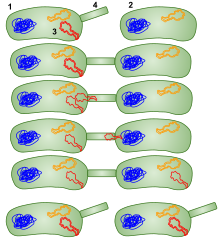Horisontal genoverførsel

Horisontal genoverførsel (HGT) eller lateral genoverførsel (LGT) er overførsel af gener fra en biota (organisme og/eller ikke-cellet liv) til en anden, uden at der er tale om nedarvning til afkom. [1] Modsat er vertikal genoverførsel overførsel af arvemateriale til afkom.
Direkte celle til celle kontakt for eksempel overførsel af plasmid fra en bakterie til andre bakterier, mennesker eller dyr – kaldet konjugation. Alternativt kan DNA overføres ved at virus trænger ind i levende organismers celler. Alternativt kan fremmed DNA optages fra fødevarer via fordøjelsessystemet.
Et eksempel på horisontal genoverførsel er at fremmed DNA kan komme fra parasitter, f.eks. at 70% af hvirvelløse dyr har indlejret store dele eller næsten hele parasitten Wolbachias genom i deres genom. [2]
Et andet eksempel er horisontal genoverførsel mellem planter – dvs højere liv. [3]
Endnu et eksempel er horisontal genoverførsel via vira og artshybrider. [4] [5]
Horisontal genoverførsel er almindelig blandt bakterier. Det menes at omkring ca. 6-25% af bakteriers genoverførsler er via horisontal genoverførsel.[3] [6] Horisontal genoverførsel menes at være en betydende faktor i udvikling af antibiotikaresistens.
Kilder/referencer
- ^ University of Queensland (2005, November 11). Lateral Thinking Produces First Map Of Gene Transmission. ScienceDaily Citat: "... Their results clearly show genetic modification of organisms by lateral transfer is a widespread natural phenomenon, and it can occur even between distantly related organisms...it was assumed that transfer of genes could only be vertical, i.e. from parents to offspring..."
- ^ University of Rochester (2007, August 31). One Species' Entire Genome Discovered Inside Another's. ScienceDaily. Retrieved November 10, 2007 Citat: "..."This study establishes the widespread occurrence and high frequency of a process that we would have dismissed as science fiction until just a few years ago," says W. Ford Doolittle, Canada Research Chair in Comparative Microbial Genomics at Dalhousie University, who is not connected to the study. "This is stunning evidence for increased frequency of gene transfer."..."This parasite has implanted itself inside the cells of 70 percent of the world's invertebrates, coevolving with them. And now, we've found at least one species where the parasite's entire or nearly entire genome has been absorbed and integrated into the host's. The host's genes actually hold the coding information for a completely separate species."..."
- ^ a b Indiana University (2003, July 10). Plant Genes Imported From Unrelated Species More Often Than Previously Thought, Biologists Find. ScienceDaily Citat: "...horizontal gene transfers, have happened more often than previously thought during the evolution of flowering plants..."It appears horizontal gene transfer occurs for just about any gene in the plant mitochondrial genome,"..."There is no reason to believe that this finding would apply only to plants...Some scientists believe that as much as 25 percent of certain bacterial species' chromosomal DNA has been acquired by way of horizontal transfer...While the mechanisms of horizontal gene transfer are still unknown, various explanations suggest that viruses, bacteria and fungi pack errant genetic material, or that accidental cross-species mating may play a role..."
- ^ Society for General Microbiology (2008, April 6). Some Of Our Oxygen Is Produced By Viruses Infecting Micro-organisms In The Oceans. ScienceDaily Citat: "..."It is beginning to become to clear to us that at least a proportion of the oxygen we breathe is a by-product of the bacteria suffering from a virus infection," says Professor Mann. "Instead of being viewed solely as evolutionary bad guys, causing diseases, viruses appear to be of central importance in the planetary process. In fact they may be essential to our survival." Viruses may also help to spread useful genes for photosynthesis from one strain of bacteria to another..."
- ^ Indiana University (2003, August 8). Cross-species Mating May Be Evolutionarily Important And Lead To Rapid Change, Say Indiana University Researchers. ScienceDaily
- ^ European Molecular Biology Laboratory (2005, July 5). Trees, Vines And Nets -- Microbial Evolution Changes Its Face. ScienceDaily Citat: "... EBI researchers have changed our view of 4 billion years of microbial evolution...In all, more than 600,000 vertical transfers are observed, coupled with 90,000 gene loss events and approximately 40,000 horizontal gene transfers...A few species, including beneficial nitrogen-fixing soil bacteria, appear to be 'champions' of horizontal gene transfer; "it's entirely possible that apparently harmless organisms are quietly spreading antibiotic resistance under our feet," concludes Christos Ouzounis..."
Se også
| Spire Denne naturvidenskabsartikel er en spire som bør udbygges. Du er velkommen til at hjælpe Wikipedia ved at udvide den. |
|
Medier brugt på denne side
Forfatter/Opretter:
- Urutseg: Blank_template.svg
- AllyUnion, Stannered: Science-symbol-2.svg
- Ain92: combination
Science stub icon.
Forfatter/Opretter: KeeperGirl12, Licens: CC BY-SA 4.0
Conjugation occurs when some bacteria have a certain gene on a plasmid that gives them an advantage, and that other bacteria don’t have. This gene usually gives the bacteria an advantage to survive in their environment, usually when the environment has antibiotics in it. A bacteria with the antibiotic resistant gene (the donor bacteria) finds a bacteria without this gene and attaches a sex pilus to it. The plasmid that gives the advantage is a double helix, which then the helixes are separated, and one strand (called T-DNA) is sent through the pilus to the other bacteria. The T-DNA in both bacteria are then replicated to become double helixes. Both bacteria can now give this plasmid with other bacteria through sex pili.

